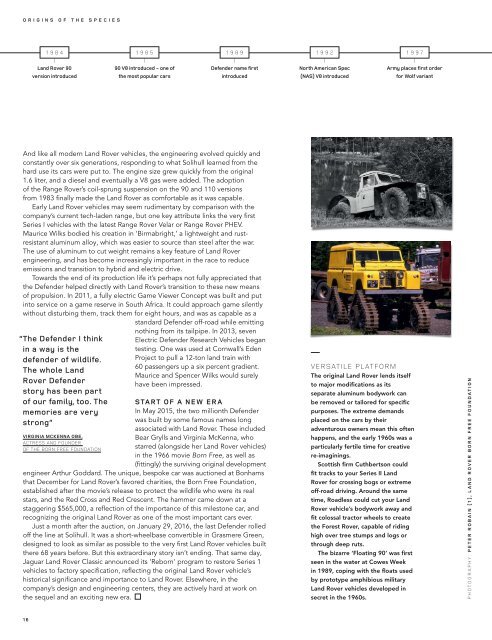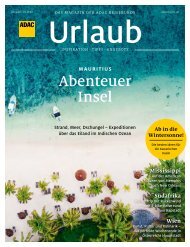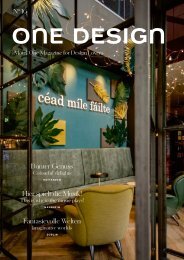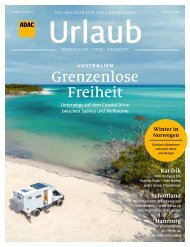ONELIFE #36 – US English
Land Rover’s Onelife magazine showcases stories from around the world that celebrate inner strength and the drive to go Above and Beyond. This special issue of Onelife marks Land Rover’s 70th anniversary – a celebration of unparalleled achievement and pioneering innovation. We bring you the incredible story of how we reunited an original 1948 car with its former owners, as well as looking back at Land Rover vehicles’ most intrepid expeditions around the globe.
Land Rover’s Onelife magazine showcases stories from around the world that celebrate inner strength and the drive to go Above and Beyond.
This special issue of Onelife marks Land Rover’s 70th anniversary – a celebration of unparalleled achievement and pioneering innovation. We bring you the incredible story of how we reunited an original 1948 car with its former owners, as well as looking back at Land Rover vehicles’ most intrepid expeditions around the globe.
Create successful ePaper yourself
Turn your PDF publications into a flip-book with our unique Google optimized e-Paper software.
ORIGINS OF THE SPECIES<br />
1984<br />
|<br />
Land Rover 90<br />
version introduced<br />
1985<br />
|<br />
90 V8 introduced - one of<br />
the most popular cars<br />
1989<br />
|<br />
Defender name first<br />
introduced<br />
1992<br />
|<br />
North American Spec<br />
(NAS) V8 introduced<br />
1997<br />
|<br />
Army places first order<br />
for Wolf variant<br />
And like all modern Land Rover vehicles, the engineering evolved quickly and<br />
constantly over six generations, responding to what Solihull learned from the<br />
hard use its cars were put to. The engine size grew quickly from the original<br />
1.6 liter, and a diesel and eventually a V8 gas were added. The adoption<br />
of the Range Rover’s coil-sprung suspension on the 90 and 110 versions<br />
from 1983 finally made the Land Rover as comfortable as it was capable.<br />
Early Land Rover vehicles may seem rudimentary by comparison with the<br />
company’s current tech-laden range, but one key attribute links the very first<br />
Series I vehicles with the latest Range Rover Velar or Range Rover PHEV.<br />
Maurice Wilks bodied his creation in ‘Birmabright,’ a lightweight and rustresistant<br />
aluminum alloy, which was easier to source than steel after the war.<br />
The use of aluminum to cut weight remains a key feature of Land Rover<br />
engineering, and has become increasingly important in the race to reduce<br />
emissions and transition to hybrid and electric drive.<br />
Towards the end of its production life it’s perhaps not fully appreciated that<br />
the Defender helped directly with Land Rover’s transition to these new means<br />
of propulsion. In 2011, a fully electric Game Viewer Concept was built and put<br />
into service on a game reserve in South Africa. It could approach game silently<br />
without disturbing them, track them for eight hours, and was as capable as a<br />
standard Defender off-road while emitting<br />
“ The Defender I think<br />
in a way is the<br />
defender of wildlife.<br />
The whole Land<br />
Rover Defender<br />
story has been part<br />
of our family, too. The<br />
memories are very<br />
strong”<br />
VIRGINIA MCKENNA OBE,<br />
ACTRESS AND FOUNDER<br />
OF THE BORN FREE FOUNDATION<br />
nothing from its tailpipe. In 2013, seven<br />
Electric Defender Research Vehicles began<br />
testing. One was used at Cornwall’s Eden<br />
Project to pull a 12-ton land train with<br />
60 passengers up a six percent gradient.<br />
Maurice and Spencer Wilks would surely<br />
have been impressed.<br />
START OF A NEW ERA<br />
In May 2015, the two millionth Defender<br />
was built by some famous names long<br />
associated with Land Rover. These included<br />
Bear Grylls and Virginia McKenna, who<br />
starred (alongside her Land Rover vehicles)<br />
in the 1966 movie Born Free, as well as<br />
(fittingly) the surviving original development<br />
engineer Arthur Goddard. The unique, bespoke car was auctioned at Bonhams<br />
that December for Land Rover’s favored charities, the Born Free Foundation,<br />
established after the movie’s release to protect the wildlife who were its real<br />
stars, and the Red Cross and Red Crescent. The hammer came down at a<br />
staggering $565,000, a reflection of the importance of this milestone car, and<br />
recognizing the original Land Rover as one of the most important cars ever.<br />
Just a month after the auction, on January 29, 2016, the last Defender rolled<br />
off the line at Solihull. It was a short-wheelbase convertible in Grasmere Green,<br />
designed to look as similar as possible to the very first Land Rover vehicles built<br />
there 68 years before. But this extraordinary story isn’t ending. That same day,<br />
Jaguar Land Rover Classic announced its ‘Reborn’ program to restore Series 1<br />
vehicles to factory specification, reflecting the original Land Rover vehicle’s<br />
historical significance and importance to Land Rover. Elsewhere, in the<br />
company’s design and engineering centers, they are actively hard at work on<br />
the sequel and an exciting new era.<br />
VERSATILE PLATFORM<br />
The original Land Rover lends itself<br />
to major modifications as its<br />
separate aluminum bodywork can<br />
be removed or tailored for specific<br />
purposes. The extreme demands<br />
placed on the cars by their<br />
adventurous owners mean this often<br />
happens, and the early 1960s was a<br />
particularly fertile time for creative<br />
re-imaginings.<br />
Scottish firm Cuthbertson could<br />
fit tracks to your Series II Land<br />
Rover for crossing bogs or extreme<br />
off-road driving. Around the same<br />
time, Roadless could cut your Land<br />
Rover vehicle’s bodywork away and<br />
fit colossal tractor wheels to create<br />
the Forest Rover, capable of riding<br />
high over tree stumps and logs or<br />
through deep ruts.<br />
The bizarre ‘Floating 90’ was first<br />
seen in the water at Cowes Week<br />
in 1989, coping with the floats used<br />
by prototype amphibious military<br />
Land Rover vehicles developed in<br />
secret in the 1960s.<br />
PHOTOGRAPHY: PETER ROBAIN (1), LAND ROVER BORN FREE FOUNDATION<br />
16


















